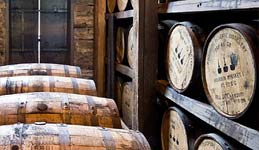Auchentoshan (1823) – originally known as Duntocher and the name has also been spelt Auckentoshan or Auchintoshan.
Bladnoch (1818) – this distillery was closed in 1994 and turned into a museum. Reopened 2000.
Glenkinchie (1837).
The following distilleries have closed:
Ayrshire: Beith (1798); Cunningham Park (1788); Irvine (1827-31); Kilbirnie (1816); Ladyburn (1966-75) – part of the Girvan grain distillery; Old Rome (1821-40); Stevenston (1816)
Clackmannanshire: Clackmannan (1821); Grange (1795-1851) – also known as Alloa; Kennetpans (1773-1825); Kilbagie (c.1700-1852) – closed from 1788-94; Linmill (1821)
Dumfries _ Galloway: Annandale (1830-1920); Bank (1825-1937) – also known as Bank of Bishoptown and Kirkcudbright; Dumfries (1795-1826); Ecclefechan (1825); Glencarrick (1831); Glentarras (1839-1914); Langholm (1765-1917) – mothballed from 1795-1818; Maxwell Town (1818); Stranraer (1825)
Dunbartonshire: Balloch (1816-29); Bellefield (1895-7); Bonhill (1825-8); Crossburn (1825); Dumbarton (1816); Duntiblae (1795) – also known as Waterside; Holm (1828-48); Inverleven (1938-91) – also known as Lomomd; Kirkintilloch (1795); Littlemill (1772-1994); Lumbrane (1825); Rohean (1798); Rountree Bank (1816); Tambowie (1825-1910) – closed due to a fire
Dundee: Dudhope (1817-26)
East Lothian: Haddington (1813) – also known as West Field or Nungate; St. Clement’s Wells (1786) – also known as Inveresk; Linton (1795-1852) – also known as Linton Bridge; Ormiston (1821-5); Prestonpans (1825); West Barns (1798)
Edinburgh: Abbeyhill (1825-6) – the site of the distillery was later used by Croftanrigh (1846-52); Caledonian (1855-1988) – also known as Edinburgh; Canongate (1795); Canonmills (1782); Coltbridge (1825); Craigentinny (1794); Dean (1881-1922); Edinburgh (1849-1925) – founded as West Sciennes. Changed name to Newington (1851), Glen Sciennes (1856), to Edinburgh Distillery 1859; Kersebank (1795-8); Leith (1798-1853) – also known as Bonnington; Leith (1825-84) – also known as Lochend and Yardheads; Lochrin (c.1780); Sunbury (1806-56) – briefly known as Edinburgh c.1850
Falkirk: Abbotshaugh (1825-8); Camelon (1798-1861) – also known as Lauriston. The buildings were later used by Rosebank; Rosebank (1842-1993) – also known as Falkirk. The distillery has been converted into a restaurant.
Fife: Auchtermuchty (1829-1926) – renamed to Stratheden in 1923; Auchtertool (1845-1927) – mothballed from 1868-83 and actually closed in 1923, but malting continued until 1927; Drumcaldie (1896-1903) – renamed Fife shortly after it was opened; Dunfermline (1795-1811); Eastbridge (1795-1848) – also known as Kirkcaldy; Eden Bank (1851); Grange (1786) – converted from a brewery that was established in 1767. This distillery was closed from 1914-8. The warehouses were used until 1987 and then converted into flats; Inverkeithing (1795-1851); Kincaple (c.1170-1809); Meldrums Mill (1816); Pitheven (1783) – also known as Pilever; Pitleasie (1816); Seggie (1810-52); Torryburn (1827)
Glasgow: Albion Place (1817-9); Barrowfield (1803-47); Belview (1825-6); Bridgeton (1816) – also known as Brigton and Hopewell; Brownfield (1816); Burnside (1824); Camlachie (1834-1920) – also known as Camlachie Lowland Malt, Whitevale and Loch Katrine; Dobbies Loan (1825-30); Dobhillock (closed 1788); Doghillock (1788); Dundashill (1770-1902); Finnieston (1824-7); Garnet Well (1825); Gorbals (1786) – also known as Kirk Street; Haghill (1837-51); Kennyhill (1827-66); Kinclaith (1958-75) – within Strathclyde Distillery and closed due to expansion of that distillery; Loch Katrine Adelphi (1826-1902) – originally known as Adelphi, but changed in 1870. Also known as Gorbals. The distillery was dismantled in 1981; Mile End (1821-52); Provanmill (1815-1929) – also known as Mile End and Milltown; Rockvilla (1814); Rutherglen Bridge (1817-23); Town Mill (1825); Tradeston (1826); Wellfield (1830) – also known as Anderston; Woodfoot (1844); Yoker (1770-1927) – also known as Renfrewshire
Lanarkshire: Airdrie (1793-1852) – also known as Tobermore; Anderston (1788-1860); Avonglen (1827-30); Bishop Bridge (1827-36) – also known as Cadder; Boggs (1795); Caldercruix (1827); Castle Hill (1827); Clydesdale (1825-1919) – also known as Wishaw; East Monkland (1825); Gartloch (1897-1921); Gill (1825-40); Glendown (1827); Kirkfield Bank; Loch (1829)
Midlothian: Balerno (1818-30); Dalkeith (1825-1827); Fisherrow (1826); House of Muir (1795); Lasswade (1825) – also known as St. Ann’s; Rathohall (1826) – also known as Ratho; Stobs (1820)
Perth _ Kinross: Hattonburn (1780)
Renfrewshire: Greenock – three distilleries with the same name, the first in Tobago Street (1795), second in Dalrymple Street (1824) and the third in Charles Street (1825-28); Lexwell (1832); Loanwells (1795); Portnauld (1787); Saucel (c.1790-1915); Smith Hills (closed 1790)
Scottish Borders: Hawick (1818)
Stirling: Baldarroch (1821-1832) – known as French Mill until 1825 and also known as Baldanack; Balmore (1833); Bankell (1816-28); Bankier (1828-1928) – maltings used until 1971; Barnshill (1795); Bogside (1818-37); Boncloich (1825-8); Bonnymuir (1828-37) – also known as Broomhill and Damhead; Burnbrae (1816); Cambusbarron (1741); Chartershall (1818-60) – also known as Charterhall and Charterishall; Coblebrae (1795); Cowie (1795-1860); Craigend (1795-1825); Denny (1814-41) – also known as East Borland; Dumbrock (1816); Glenalrig (1825-6); Holland Bush (1827); Kepp (1795-1842) – divided in 1825 into two distilleries: Westerkepp and Easterkepp; Kerse Mill (1818-29); Lauriston (1821); Lillyburn (1825); Littlecarse (1795); Mains (1825); Oldhall (1816); Pirniehall; Polmont (1822); Robert Burns (1825); Sauchenford (1793); Springfield (1829); Stirling (1817); Stonnywood (1785); Underwood (1780-1826)
West Lothian: Blackburn (1790); Bo’ness (1813-1925) – also known as Borrowstouness. The Grieve Brothers distillery was also known as Bo’ness; Bonnytown (1795-1826) – merged with St. Magdalene in the 1810’s; Down (1798); Glenmavis (1783-1910); Grieve Brothers (1817-42) – also known as Bo’ness, but there was a separate distillery by that name in Bo’ness itself; Kirkliston (1795-c.1900) – also known as Glen Forth Distillery and Queensferry, now used as a malting plant; Loch (1816); Smallhills (1795); St. Magdalene (1797-1983) – also known as Linlithgow, this distillery merged with Bonnytown in the 1810’s; Torphichen (1795); Wallace Paw (1795)
Exact locations unknown: Milnamuir (1788) – also known as Ailnamuir; Richardtown (1795)
 TravelDock
TravelDock 